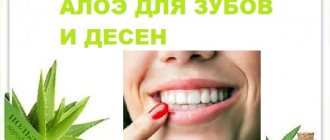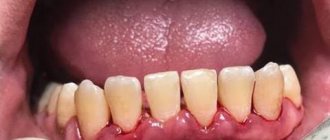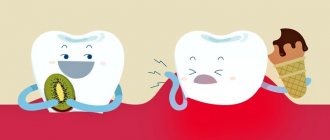March 13, 2020
If you sometimes use traditional medicine recipes, then you will be interested to learn in detail about a plant such as sage. It helps with toothache, it is used to rinse gums, and is used to prevent dental diseases as part of rinses and pastes. Journalists from the UltraSmile.ru editorial team will reveal to you all the secrets of this useful natural medicine.
Sage is often used in folk medicine
Valuable properties of medicinal plants for teeth and gums
In folk medicine you can find many recipes that use sage for gums and teeth. And this is not surprising, because the medicinal plant has a set of positive properties:
- relieves pain
- disinfects,
- freshens breath,
- strengthens local immunity,
- accelerates tissue regeneration (restoration),
- has an astringent effect and stops bleeding, strengthens capillaries,
- has an anti-inflammatory and decongestant effect, and also eliminates signs of the inflammatory process.
A decoction of sage helps eliminate many dental problems.
A decoction of this plant is completely safe if accidentally swallowed in small quantities; moreover, it helps normalize digestion. Its aroma calms the nervous system and helps improve sleep. Therefore, it can be used not only by adults, but also by children.
Sage is rich in natural (organic) antibiotics, tannins1 and cineole (antiseptic), potassium, phosphorus and calcium, it contains antioxidants, as well as vitamins A, E, K. All of these components are very important for the health of teeth and gums.
How does sage work for gum inflammation and toothache?
Sage tops the list of medicinal herbs for the treatment of diseases of the throat and oral cavity. Its high efficiency is explained by its chemical composition:
- The vitamin-mineral complex makes the gums stronger and more elastic, prevents tissue loss and accelerates regeneration.
- Phytoncides - make the epithelium more resistant to external influences.
- Resins – envelop mucous tissues and create a bactericidal film.
- Acids soften the mucous membrane and accelerate its healing.
- Astringent components – relieve pain and reduce gum bleeding.
- Aroma components - freshen breath.
For what dental problems can sage be used?
Many people note that sage is effective for toothache of mild to moderate intensity. It helps reduce the level of discomfort caused by caries or pulpitis. But much more often it is used for rinsing gums for stomatitis, gingivitis, periodontitis and periodontal disease, gum abscess and suppuration, open wounds and ulcers on the mucous membrane.
The product is often used as a rinse for gum inflammation.
A decoction of this valuable plant will not replace a trip to the dentist, but in combination with other treatment measures recommended by a specialist, it can contribute to the fight against oral diseases!
A decoction from a medicinal plant will help in the fight against halitosis (bad breath), but, naturally, only if you take other measures to eliminate it: treat diseases of the teeth and gums at the dentist, undergo professional oral hygiene, limit consumption of certain foods (garlic, protein and carbohydrate foods).
Bad breath can also be eliminated with sage decoction.
Sage for rinsing gums is recognized by many researchers as one of the most effective2 remedies along with eucalyptus, St. John's wort and yarrow. It can be used not only when problems have already appeared, but also for the prevention of dental diseases. It helps make gums elastic, increases their resistance to bacterial attack, and promotes rapid healing of wounds and cracks. They not only rinse the mouth with sage, but also make applications, lotions, and oral baths with it.
Contraindications for use that you need to know about
Sage for gums and teeth should not be used if you suffer from epilepsy, thyroid or kidney diseases. Contraindication is individual intolerance or allergic reactions in the form of redness, rash, itching. The use of sage decoctions is not recommended for children under 5 years of age, as they have a higher risk of encountering the negative properties of the medicine if they swallow a large amount or in case of an overdose.
Buy sage only in pharmacies, as this is where the medicinal herb is delivered. It is not recommended to collect the plant in meadows or gardens, because in these places mainly wild and meadow or ornamental varieties grow, which will not be useful.
Pregnant and lactating women should be treated with this remedy with caution. In pregnant women, sage can cause cramps, and in nursing women it can reduce the amount of milk produced. But these properties appear only with an overdose or systematic ingestion.
Pregnant women should use this product with caution
This medicine should be used in moderation and for no more than 2 months in a row. Firstly, an overdose can cause poisoning, dizziness and severe headaches. Secondly, longer use can be addictive, as well as provoke the development of allergies and swelling of the nasopharynx.
Popular folk recipes with sage
Strong warm decoction for toothache
Brew sage firmly for toothache. To do this, pour 2 tablespoons of the crushed plant into a glass of boiling water and keep it on low heat for five minutes. The resulting mixture is cooled and filtered, after which it is taken into the mouth and held in the area of the diseased tooth for several minutes. You can repeat every hour.
The solution for children under 5 years of age should be much weaker than for adults. If you put 2 tablespoons in a glass of boiling water, then only half of one spoon is enough for your child. This is due to the fact that the child has a greater risk of allergies and intoxication of the body in case of an overdose.
Herbal mixture for bleeding gums
To be effective, sage is enhanced with other herbs: chamomile, St. John's wort and yarrow. To prepare the decoction, you will need 2 teaspoons of each component and 200 ml of hot water. Next, the composition is infused for half an hour and used twice a day, morning and evening, to rinse the gums.
Herbal tea with sage is used for bleeding gums
Never buy sage secondhand from those who claim to grow it. There are many varieties of this plant, and among them is Salvia divinórum (Divinor Sage), which can cause hallucinations due to the component it contains, the hallucinogen salvinorin.
Solution with hydrogen peroxide and aloe juice for the treatment of stomatitis
The sequence of actions is as follows:
- prepare a sage decoction and cool it to room temperature: 1 teaspoon per glass of boiling water,
- separately in 1 glass of boiled water, stir 1 teaspoon of peroxide,
- add one teaspoon of hydrogen peroxide solution to the prepared broth. Add 5 teaspoons of aloe juice to this. Mix all ingredients thoroughly and let it brew in a dark place for 2-3 hours.
Rinse your mouth at least 2 times a day.
With oak bark for inflammation of periodontal tissues
For half a liter of boiling water you will need 1 tablespoon each of oak and sage bark. The broth is infused for half an hour, then filtered and rinsed with mouth 3 times a day.
With essential oil for fresh breath
Suitable only for those who are not prone to allergies! Add 3-5 drops of sage essential oil to a glass of warm boiled water and rinse your mouth twice a day, morning and evening, after careful oral hygiene.
Sage herb
Sage is a herbaceous plant that came to our country from southeastern Europe. They began to grow it in fields, orchards and vegetable gardens. The plant does not tolerate harsh winters with thin snow cover. In such conditions, the sage freezes and does not sprout in the spring. The roots of the grass do not tolerate waterlogging, so it does not grow in swamps. Dry fields are more favorable for sage than waterlogged lowlands.
The plant rarely reaches 70 cm in height. The root system is powerful and woody. In the first year of vegetation, the base of the plant is formed - a bush-like one. The first flowering is expected in the second year from early to mid-summer. Leaves and tops of inflorescences are collected as medicinal raw materials. Leaves are collected from the first year plant once, in September. Later, harvesting can be done several times during the summer, until September. Before wintering, the entire above-ground part is mowed down.
Medicines that contain sage
As noted above, in dentistry, medicinal plants are more often used for complex treatment of mucous membranes and gums. This fact is confirmed by the list of drugs that include sage.
| Drug name | Peculiarities | Cost, in rubles |
| "Periodonticide" | Russian drug. Available in the form of a spray and oral solution. It has an analgesic, anti-inflammatory and antiseptic effect. It is prescribed as part of complex treatment of gingivitis, periodontitis, stomatitis | From 100 |
| "Stomatofit" | An analogue of “Parodontocide”, only made in Poland, and its price is higher. Used for any inflammation of the oral cavity, including ulcers caused by rubbing with removable dentures | From 200 |
| "Elakosept" | Medicinal collection in two forms of release - crushed herbs and filter bags. You need to prepare a fresh infusion from it as needed. Suitable for the treatment of aphthous stomatitis, oral lichen planus | From 80 |
| "Fitantis" | The medicinal collection has an antimicrobial, anti-inflammatory, astringent effect. Effective for stomatitis and gingivitis | From 150 |
| "Salvin" | An alcohol solution that is prescribed for periodontal disease, ulcerative gingivitis, acute aphthous stomatitis, and abscesses. They wash wounds and periodontal pockets (the spaces between the gum and tooth) | From 120 |
| Dissolving tablets and lozenges | Used for complex therapy of inflammatory diseases of the oral cavity and upper respiratory tract. Relieves pain from gingivitis and stomatitis | From 100 |
“The other day, a friend gave me Sunny Bunny tooth powder, which contains a lot of herbs and sage. The box says that it can be used by adults and children, and that it is a good prevention of periodontitis, stomatitis, and tartar. I bought it somewhere in Altai when I went on vacation. We've never seen anything like this in pharmacies. Now the whole family uses it and, I hope, we protect our teeth and gums well from all sorts of diseases.”
Nino, review from woman.ru
Sage is also included in many toothpastes and rinses for sensitive teeth and gums. For example, in the series of daily oral care products “Forest Balm”, PresiDENT.
Notice
: Undefined variable: post_id in
/home/c/ch75405/public_html/wp-content/themes/UltraSmile/single-item.php
on line
45 Notice
: Undefined variable: full in
/home/c/ch75405/public_html/wp-content /themes/UltraSmile/single-item.php
on line
46
Rate this article:
( 1 ratings, average: 5.00 out of 5)
prevention
- Mironov S.E., Fetisova A.N. The state of the Russian market of pharmaceutical products of plant origin for the prevention and treatment of inflammatory diseases of the oral cavity // Medical and pharmaceutical journal “Pulse”. – 2013.
- Goncharova E.I. Herbal remedies in the prevention and treatment of periodontal diseases // Russian Dental Journal. – 2012.
Expert “Sage is an excellent natural antiseptic. It increases the protective functions of the oral mucosa. It is good for preventing dental diseases, but if the problem really appears, then herbs alone will not get rid of it. Moreover, many patients using medicinal plants only worsen their condition. Various decoctions “lubricate” the overall picture; they stop inflammation, but do not eliminate the causes of its occurrence, and time is running out.” Dentist therapist, periodontist Marina Igorevna Tarabanovskaya
Consulting specialist
Tarabanovskaya Marina Igorevna
Specialization: Dentist therapist, periodontist Experience: 10 years
Sage medicinal properties
The entire plant, not only in the leaves and flowers, but also in the stem and cuttings, contains essential oil, which contains camphor, cineole, pinene and monoterpine. The leaves contain alkaloids, tannins, ursolic acid and flavonoids. As a result of flowering, the plant is saturated with fatty oils, consisting mainly of linoleic acid glycerides.
Sage is used as a medicine for local and external therapy. The therapeutic effect is achieved through combinations of components with vitamins and minerals that complement the effects of biologically active chemicals. Most often, sage is used as a complex therapy for the following disorders:
- inflammation of the urinary system;
- diseases of the reproductive system in women;
- inflammatory processes of mucous membranes;
- dermatitis;
- digestive system disorders;
- nervous system disorders.
Depending on the disease, the dosage is calculated strictly individually in accordance with hormonal levels and possible adverse reactions. An infusion of leaves has an antimicrobial effect, disinfects the treated surface and prevents the addition of a secondary infection. Additionally, it relieves inflammation locally.
Effective as a rinse for gingivitis and stomatitis. In addition, sage is prescribed for sore throats as an herbal remedy to relieve swelling and reduce the severity of inflammation of the tonsils. Sage leaves and flowers are classified as dietary supplements.
Comments
Will sage help if the gums under the bridge are inflamed and there is a bad smell coming from there? What other measures should I take?
Vladimir Grigorievich (03/24/2020 at 02:09) Reply to comment
- Dear Vladimir Grigorievich, inflammation of the gums in the area where the bridge prosthesis adjoins it is a common phenomenon. Most often this is caused by poor oral hygiene. Perhaps you are not properly cleaning the area between the denture and the gum, where food debris gets clogged, it rots and causes inflammation. In this case, a decoction of sage will really help eliminate inflammation and bad odor. And for better and more thorough hygiene, purchase an irrigator.











